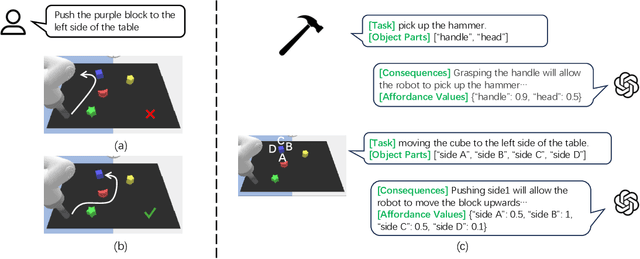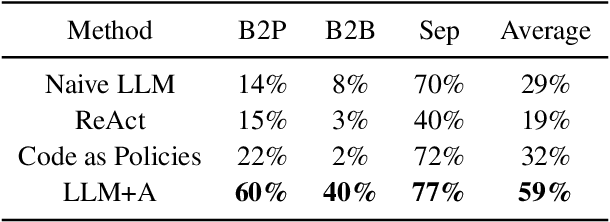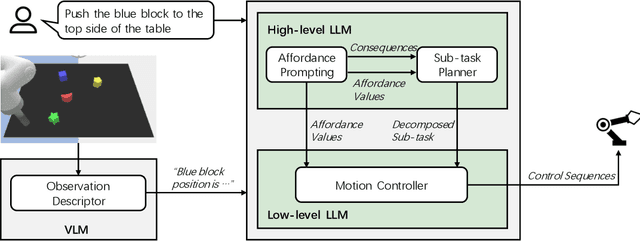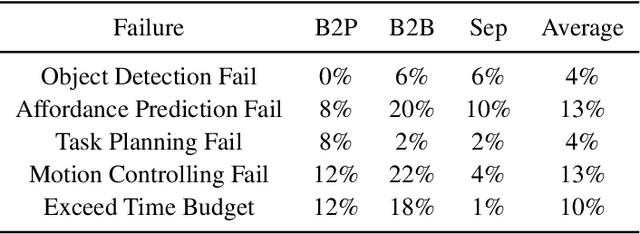Wenzhe Cai
NavDP: Learning Sim-to-Real Navigation Diffusion Policy with Privileged Information Guidance
May 13, 2025Abstract:Learning navigation in dynamic open-world environments is an important yet challenging skill for robots. Most previous methods rely on precise localization and mapping or learn from expensive real-world demonstrations. In this paper, we propose the Navigation Diffusion Policy (NavDP), an end-to-end framework trained solely in simulation and can zero-shot transfer to different embodiments in diverse real-world environments. The key ingredient of NavDP's network is the combination of diffusion-based trajectory generation and a critic function for trajectory selection, which are conditioned on only local observation tokens encoded from a shared policy transformer. Given the privileged information of the global environment in simulation, we scale up the demonstrations of good quality to train the diffusion policy and formulate the critic value function targets with contrastive negative samples. Our demonstration generation approach achieves about 2,500 trajectories/GPU per day, 20$\times$ more efficient than real-world data collection, and results in a large-scale navigation dataset with 363.2km trajectories across 1244 scenes. Trained with this simulation dataset, NavDP achieves state-of-the-art performance and consistently outstanding generalization capability on quadruped, wheeled, and humanoid robots in diverse indoor and outdoor environments. In addition, we present a preliminary attempt at using Gaussian Splatting to make in-domain real-to-sim fine-tuning to further bridge the sim-to-real gap. Experiments show that adding such real-to-sim data can improve the success rate by 30\% without hurting its generalization capability.
ImagineNav: Prompting Vision-Language Models as Embodied Navigator through Scene Imagination
Oct 13, 2024Abstract:Visual navigation is an essential skill for home-assistance robots, providing the object-searching ability to accomplish long-horizon daily tasks. Many recent approaches use Large Language Models (LLMs) for commonsense inference to improve exploration efficiency. However, the planning process of LLMs is limited within texts and it is difficult to represent the spatial occupancy and geometry layout only by texts. Both are important for making rational navigation decisions. In this work, we seek to unleash the spatial perception and planning ability of Vision-Language Models (VLMs), and explore whether the VLM, with only on-board camera captured RGB/RGB-D stream inputs, can efficiently finish the visual navigation tasks in a mapless manner. We achieve this by developing the imagination-powered navigation framework ImagineNav, which imagines the future observation images at valuable robot views and translates the complex navigation planning process into a rather simple best-view image selection problem for VLM. To generate appropriate candidate robot views for imagination, we introduce the Where2Imagine module, which is distilled to align with human navigation habits. Finally, to reach the VLM preferred views, an off-the-shelf point-goal navigation policy is utilized. Empirical experiments on the challenging open-vocabulary object navigation benchmarks demonstrates the superiority of our proposed system.
MO-DDN: A Coarse-to-Fine Attribute-based Exploration Agent for Multi-object Demand-driven Navigation
Oct 04, 2024Abstract:The process of satisfying daily demands is a fundamental aspect of humans' daily lives. With the advancement of embodied AI, robots are increasingly capable of satisfying human demands. Demand-driven navigation (DDN) is a task in which an agent must locate an object to satisfy a specified demand instruction, such as ``I am thirsty.'' The previous study typically assumes that each demand instruction requires only one object to be fulfilled and does not consider individual preferences. However, the realistic human demand may involve multiple objects. In this paper, we introduce the Multi-object Demand-driven Navigation (MO-DDN) benchmark, which addresses these nuanced aspects, including multi-object search and personal preferences, thus making the MO-DDN task more reflective of real-life scenarios compared to DDN. Building upon previous work, we employ the concept of ``attribute'' to tackle this new task. However, instead of solely relying on attribute features in an end-to-end manner like DDN, we propose a modular method that involves constructing a coarse-to-fine attribute-based exploration agent (C2FAgent). Our experimental results illustrate that this coarse-to-fine exploration strategy capitalizes on the advantages of attributes at various decision-making levels, resulting in superior performance compared to baseline methods. Code and video can be found at https://sites.google.com/view/moddn.
InstructNav: Zero-shot System for Generic Instruction Navigation in Unexplored Environment
Jun 07, 2024



Abstract:Enabling robots to navigate following diverse language instructions in unexplored environments is an attractive goal for human-robot interaction. However, this goal is challenging because different navigation tasks require different strategies. The scarcity of instruction navigation data hinders training an instruction navigation model with varied strategies. Therefore, previous methods are all constrained to one specific type of navigation instruction. In this work, we propose InstructNav, a generic instruction navigation system. InstructNav makes the first endeavor to handle various instruction navigation tasks without any navigation training or pre-built maps. To reach this goal, we introduce Dynamic Chain-of-Navigation (DCoN) to unify the planning process for different types of navigation instructions. Furthermore, we propose Multi-sourced Value Maps to model key elements in instruction navigation so that linguistic DCoN planning can be converted into robot actionable trajectories. With InstructNav, we complete the R2R-CE task in a zero-shot way for the first time and outperform many task-training methods. Besides, InstructNav also surpasses the previous SOTA method by 10.48% on the zero-shot Habitat ObjNav and by 86.34% on demand-driven navigation DDN. Real robot experiments on diverse indoor scenes further demonstrate our method's robustness in coping with the environment and instruction variations.
Empowering Large Language Models on Robotic Manipulation with Affordance Prompting
Apr 17, 2024



Abstract:While large language models (LLMs) are successful in completing various language processing tasks, they easily fail to interact with the physical world by generating control sequences properly. We find that the main reason is that LLMs are not grounded in the physical world. Existing LLM-based approaches circumvent this problem by relying on additional pre-defined skills or pre-trained sub-policies, making it hard to adapt to new tasks. In contrast, we aim to address this problem and explore the possibility to prompt pre-trained LLMs to accomplish a series of robotic manipulation tasks in a training-free paradigm. Accordingly, we propose a framework called LLM+A(ffordance) where the LLM serves as both the sub-task planner (that generates high-level plans) and the motion controller (that generates low-level control sequences). To ground these plans and control sequences on the physical world, we develop the affordance prompting technique that stimulates the LLM to 1) predict the consequences of generated plans and 2) generate affordance values for relevant objects. Empirically, we evaluate the effectiveness of LLM+A in various language-conditioned robotic manipulation tasks, which show that our approach substantially improves performance by enhancing the feasibility of generated plans and control and can easily generalize to different environments.
XuanCe: A Comprehensive and Unified Deep Reinforcement Learning Library
Dec 25, 2023Abstract:In this paper, we present XuanCe, a comprehensive and unified deep reinforcement learning (DRL) library designed to be compatible with PyTorch, TensorFlow, and MindSpore. XuanCe offers a wide range of functionalities, including over 40 classical DRL and multi-agent DRL algorithms, with the flexibility to easily incorporate new algorithms and environments. It is a versatile DRL library that supports CPU, GPU, and Ascend, and can be executed on various operating systems such as Ubuntu, Windows, MacOS, and EulerOS. Extensive benchmarks conducted on popular environments including MuJoCo, Atari, and StarCraftII multi-agent challenge demonstrate the library's impressive performance. XuanCe is open-source and can be accessed at https://github.com/agi-brain/xuance.git.
DGMem: Learning Visual Navigation Policy without Any Labels by Dynamic Graph Memory
Nov 30, 2023Abstract:In recent years, learning-based approaches have demonstrated significant promise in addressing intricate navigation tasks. Traditional methods for training deep neural network navigation policies rely on meticulously designed reward functions or extensive teleoperation datasets as navigation demonstrations. However, the former is often confined to simulated environments, and the latter demands substantial human labor, making it a time-consuming process. Our vision is for robots to autonomously learn navigation skills and adapt their behaviors to environmental changes without any human intervention. In this work, we discuss the self-supervised navigation problem and present Dynamic Graph Memory (DGMem), which facilitates training only with on-board observations. With the help of DGMem, agents can actively explore their surroundings, autonomously acquiring a comprehensive navigation policy in a data-efficient manner without external feedback. Our method is evaluated in photorealistic 3D indoor scenes, and empirical studies demonstrate the effectiveness of DGMem.
Robust Navigation with Cross-Modal Fusion and Knowledge Transfer
Sep 23, 2023Abstract:Recently, learning-based approaches show promising results in navigation tasks. However, the poor generalization capability and the simulation-reality gap prevent a wide range of applications. We consider the problem of improving the generalization of mobile robots and achieving sim-to-real transfer for navigation skills. To that end, we propose a cross-modal fusion method and a knowledge transfer framework for better generalization. This is realized by a teacher-student distillation architecture. The teacher learns a discriminative representation and the near-perfect policy in an ideal environment. By imitating the behavior and representation of the teacher, the student is able to align the features from noisy multi-modal input and reduce the influence of variations on navigation policy. We evaluate our method in simulated and real-world environments. Experiments show that our method outperforms the baselines by a large margin and achieves robust navigation performance with varying working conditions.
Bridging Zero-shot Object Navigation and Foundation Models through Pixel-Guided Navigation Skill
Sep 21, 2023Abstract:Zero-shot object navigation is a challenging task for home-assistance robots. This task emphasizes visual grounding, commonsense inference and locomotion abilities, where the first two are inherent in foundation models. But for the locomotion part, most works still depend on map-based planning approaches. The gap between RGB space and map space makes it difficult to directly transfer the knowledge from foundation models to navigation tasks. In this work, we propose a Pixel-guided Navigation skill (PixNav), which bridges the gap between the foundation models and the embodied navigation task. It is straightforward for recent foundation models to indicate an object by pixels, and with pixels as the goal specification, our method becomes a versatile navigation policy towards all different kinds of objects. Besides, our PixNav is a pure RGB-based policy that can reduce the cost of home-assistance robots. Experiments demonstrate the robustness of the PixNav which achieves 80+% success rate in the local path-planning task. To perform long-horizon object navigation, we design an LLM-based planner to utilize the commonsense knowledge between objects and rooms to select the best waypoint. Evaluations across both photorealistic indoor simulators and real-world environments validate the effectiveness of our proposed navigation strategy. Code and video demos are available at https://github.com/wzcai99/Pixel-Navigator.
Discuss Before Moving: Visual Language Navigation via Multi-expert Discussions
Sep 20, 2023



Abstract:Visual language navigation (VLN) is an embodied task demanding a wide range of skills encompassing understanding, perception, and planning. For such a multifaceted challenge, previous VLN methods totally rely on one model's own thinking to make predictions within one round. However, existing models, even the most advanced large language model GPT4, still struggle with dealing with multiple tasks by single-round self-thinking. In this work, drawing inspiration from the expert consultation meeting, we introduce a novel zero-shot VLN framework. Within this framework, large models possessing distinct abilities are served as domain experts. Our proposed navigation agent, namely DiscussNav, can actively discuss with these experts to collect essential information before moving at every step. These discussions cover critical navigation subtasks like instruction understanding, environment perception, and completion estimation. Through comprehensive experiments, we demonstrate that discussions with domain experts can effectively facilitate navigation by perceiving instruction-relevant information, correcting inadvertent errors, and sifting through in-consistent movement decisions. The performances on the representative VLN task R2R show that our method surpasses the leading zero-shot VLN model by a large margin on all metrics. Additionally, real-robot experiments display the obvious advantages of our method over single-round self-thinking.
 Add to Chrome
Add to Chrome Add to Firefox
Add to Firefox Add to Edge
Add to Edge